For decades, marketers have relied on demographics and surveys to understand consumer behavior. But what if we could peek beneath the surface, delving into the very neural mechanisms that drive our choices and desires?
Imagine crafting campaigns that tap into the brain’s reward system, triggering dopamine spikes of delight with every interaction. Or, visualize designing packaging that subconsciously influences decision-making through subtle color cues that resonate with the limbic system, the emotional epicenter of our brains.
This isn’t science fiction; it’s the cutting edge of marketing, and it’s poised to reshape the way we connect with consumers on a fundamental level.
Dive into the World of Neuroscience in Marketing
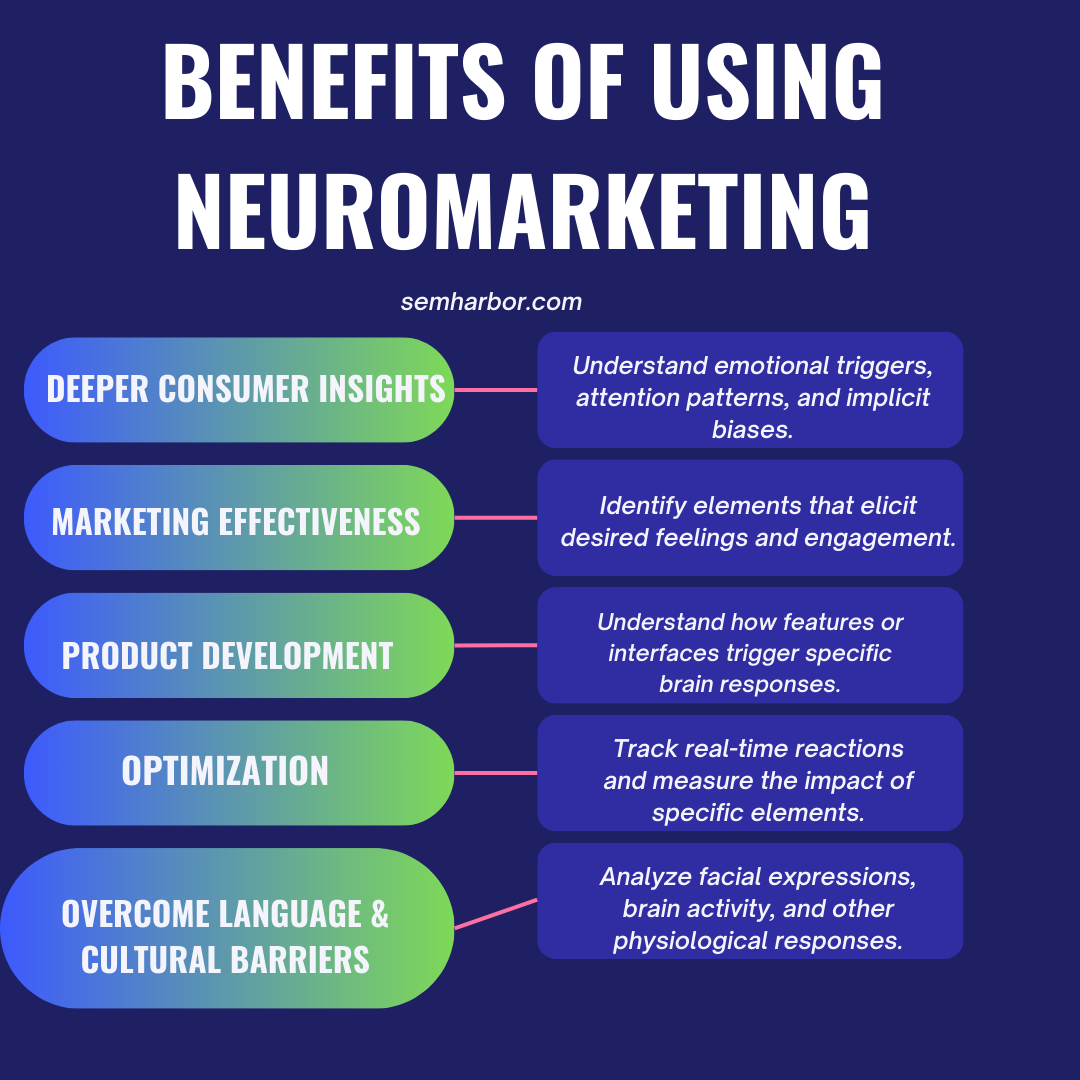
What is Neuromarketing?
Neuromarketing is the study of how people’s brains respond to marketing stimuli, such as advertisements, packaging, and even product placement.
It utilizes tools like functional magnetic resonance imaging (fMRI) and electroencephalography (EEG) to measure brain activity, along with physiological responses like eye tracking and skin conductance.
By analyzing these signals, researchers gain insights into consumers’ subconscious preferences, motivations, and decision-making processes.
How Does Neuro Marketing Work?
Neuromarketing employs various techniques to measure brain activity and physiological responses. Here are some key players:
- fMRI (functional Magnetic Resonance Imaging): Imagine a detailed map of brain activity, lighting up regions as they process information. fMRI measures blood flow changes, revealing which areas are engaged during product interaction or ad exposure.
- EEG (Electroencephalography): This less invasive technique uses sensors on the scalp to capture electrical activity, providing insights into emotional responses and attentional focus.
- Eye Tracking: Forget surveys, these devices track where your gaze wanders, unveiling what grabs your visual interest and for how long.
- Biometric Measures: Heart rate, skin conductance, and even facial expressions tell a story – an increased rate could indicate excitement, while flushed cheeks might suggest positive engagement.
Decoding the Signals:
By analyzing these combined data streams, neuro marketers aim to understand:
- Emotional Resonance: Does the packaging evoke trust? Does the ad trigger excitement? Neuromarketing sheds light on the emotional impact of stimuli, guiding design and messaging to resonate deeper.
- Decision-Making Pathways: By observing brain activity during choices, neuromarketing can identify factors influencing purchase decisions, helping create more persuasive marketing strategies.
- Attention Allocation: Where are consumers focusing their attention? Neuromarketing helps optimize website layouts, product designs, and ad formats to capture and hold that focus effectively.
Benefits of Using Neuromarketing
- Unmask the “Why” Behind Choices: Forget self-reported data filled with biases and social desirability.
Neuromarketing techniques like EEG and eye-tracking reveal the true emotional and cognitive responses to your brand, packaging, and advertising.
This deeper understanding helps you craft messages that resonate on a fundamental level, leading to stronger brand loyalty and advocacy.
- Design: Forget A/B testing. Neuromarketing can pinpoint the specific design elements that trigger positive emotions and attention.
This data-driven approach helps you create websites, packaging, and even physical stores that are inherently user-friendly and emotionally engaging, leading to higher conversion rates and repeat business.
- Compelling Stories: Stories are powerful marketing tools, but what makes a story truly captivating?
Neuromarketing can identify the specific elements that trigger emotional engagement, memory encoding, and even empathy.
This data empowers you to create stories that resonate deeply with your target audience, building lasting connections and brand trust.
- Innovate: Developing new products is risky, but neuromarketing can mitigate that risk.
By testing prototypes and concepts with real users, you can see their subconscious reactions to features, design elements, and even pricing.
This data-driven approach helps you refine your product before launch, ensuring it resonates with your target audience and maximizing its success.
- Demographics: Traditional marketing often segments audiences based on demographics.
But neuromarketing reveals the deeper psychological and emotional drivers that unite seemingly disparate groups.
This understanding allows you to create targeted campaigns that speak to shared desires and aspirations, fostering deeper connections with your audience regardless of age, income, or location.
Remember, neuromarketing is not about manipulation, but about understanding.
Ethical Considerations in Neuromarketing
While exciting, neuromarketing raises ethical concerns, prompting questions about potential manipulation and privacy breaches. It’s crucial to:
- Transparency: Inform participants about the research objectives and data usage.
- Informed Consent: Ensure participants freely choose to participate.
- Responsible Interpretation: Avoid over-generalizations and respect individual variability.
- Data Security: Implement robust safeguards to protect sensitive personal information.
Delving into the Power of Neuromarketing
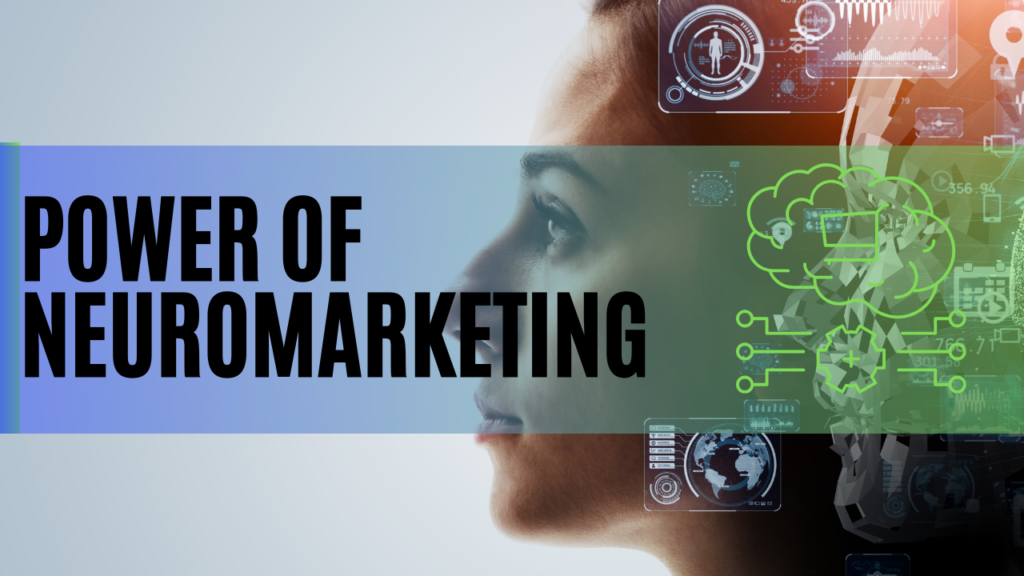
Understanding the Hidden Language of the Brain
Think of it this way: imagine a consumer testing a new car. They might tell you it’s comfortable and stylish, but their brain activity paints a different picture. Increased activity in the reward center hints at subconscious excitement, while a spike in the amygdala suggests hidden concerns about safety. Neuromarketing bridges this gap, providing marketers with invaluable data that informs everything from product design to advertising campaigns.
So, what exactly can you learn from this “hidden language”? Here are just a few:
- Emotional Triggers: Discover what elements in your marketing materials evoke positive emotions like trust, excitement, or nostalgia, leading to stronger brand connections.
- Attention Magnets: Identify which visuals, sounds, or messages capture and hold attention, maximizing the impact of your campaigns.
- Decision Drivers: Understand the subconscious factors influencing purchase decisions, allowing you to tailor your offerings and messaging for maximum effectiveness.
- Product Perfection: Gain insights into how users interact with your product, identifying areas for improvement and ensuring a seamless, intuitive experience.
Unconscious Influences and Decision-Making
Imagine strolling through a supermarket, confidently filling your cart with healthy items. Suddenly, a brightly colored display of cookies catches your eye. Before you know it, a box ends up in your basket, despite your good intentions.
What happened? Enter the realm of unconscious influences, the hidden puppeteers pulling the strings of our decision-making.
While we like to think of ourselves as rational beings, weighing pros and cons before every choice, research paints a different picture. Our subconscious mind exerts a powerful influence on our decisions, shaped by a complex interplay of factors including:
- Emotions: Fear, happiness, and even hunger can subtly nudge us toward particular choices. A calming scent in a store might subconsciously make you linger and spend more.
- Heuristics: Mental shortcuts based on past experiences. Seeing a product with a “bestseller” label triggers feelings of trust and desirability, making you more likely to choose it.
- Implicit biases: Unconscious prejudices we hold towards certain groups, leading to skewed decisions without our awareness. A product associated with a group you subconsciously hold a positive bias toward might become instantly appealing.
- Environmental cues: Subtle details like music, lighting, and product placement can subconsciously influence your perception and behavior. Upbeat music might make you browse faster, while dim lighting might create a more relaxed and spend-happy mood.
Understanding these hidden influences is crucial for navigating the world around us consciously. Here are some tips:
- Slow down: Don’t rush into decisions, especially under pressure. Give yourself time to reflect and question the “why” behind your choices.
- Recognize automatic thoughts: Pay attention to your gut feeling, but don’t blindly follow it. Analyze if it’s based on logic or subconscious biases.
- Be mindful of your environment: Notice how factors like music, lighting, and product placement might be influencing your decisions.
- Educate yourself: Learn about common marketing tactics and implicit biases to become more aware of their potential impact.
So, the next time you reach for that box of cookies, take a moment to pause and ask yourself: Is this my conscious choice, or is the puppeteer pulling the strings?
Measuring Emotions and Attention with Neuroscience Tools
Imagine measuring excitement as consumers view your new product with electroencephalography (EEG), gauging engagement with eye-tracking technology, or detecting hidden anxieties through facial expression analysis. These are just a few of the tools in the neuromarketing arsenal, offering data far richer than traditional methods.
The Rise of Neuromarketing Companies
Neuromarketing, once a futuristic concept, is rapidly gaining traction. Companies like Brainlabs are using cutting-edge tools like EEG, fMRI, and eye-tracking to measure brain activity, emotions, and attention in response to marketing stimuli. This data provides unparalleled insights into what truly resonates with consumers, going beyond traditional self-reported information.
The neuromarketing landscape is diverse, with companies catering to specific needs and industries. Here are a few noteworthy examples:
- Nielsen Consumer Neuroscience: A global leader offering a wide range of services, including brain imaging, eye-tracking, and biometrics.
- CloudArmy: Renowned for their Reactor platform, offering agile and scalable neuro-behavioral research solutions.
Ethical Considerations and Consumer Privacy
- Transparency is Key: Companies must be upfront about the data they collect, how it’s used, and with whom it’s shared. Clear, jargon-free privacy policies are essential for building trust.
- Consent Matters: Obtaining informed consent, not just a checkbox click, is crucial. Individuals should understand the implications of sharing their data and have the right to withdraw consent at any time.
- Data Minimization: Collect only the information necessary for the intended purpose. Avoid amassing vast data troves beyond immediate needs.
- Security is Paramount: Robust security measures are essential to protect data from breaches and unauthorized access. Regular audits and updates are crucial.
- Purpose Limitation: Data collected for a specific purpose shouldn’t be used for something entirely different without explicit consent. Respect the boundaries of user intent.
Beyond Legal Frameworks:
Regulations like GDPR and CCPA offer a minimum threshold for data protection, but ethical considerations go beyond legal mandates. Companies must go the extra mile:
- Respect Individual Autonomy: Recognize that users are not just data points, but individuals with rights and choices. Empower them to control their data destiny.
- Consider Algorithmic Bias: Be mindful of potential biases in data collection and analysis that could unfairly discriminate against certain groups. Promote algorithmic fairness.
- Address Societal Impact: Consider the broader societal implications of data collection and use. Be responsible for potential downstream effects on vulnerable populations or social dynamics.
Neuroscience in Marketing: Unveiling the Secrets of Persuasion
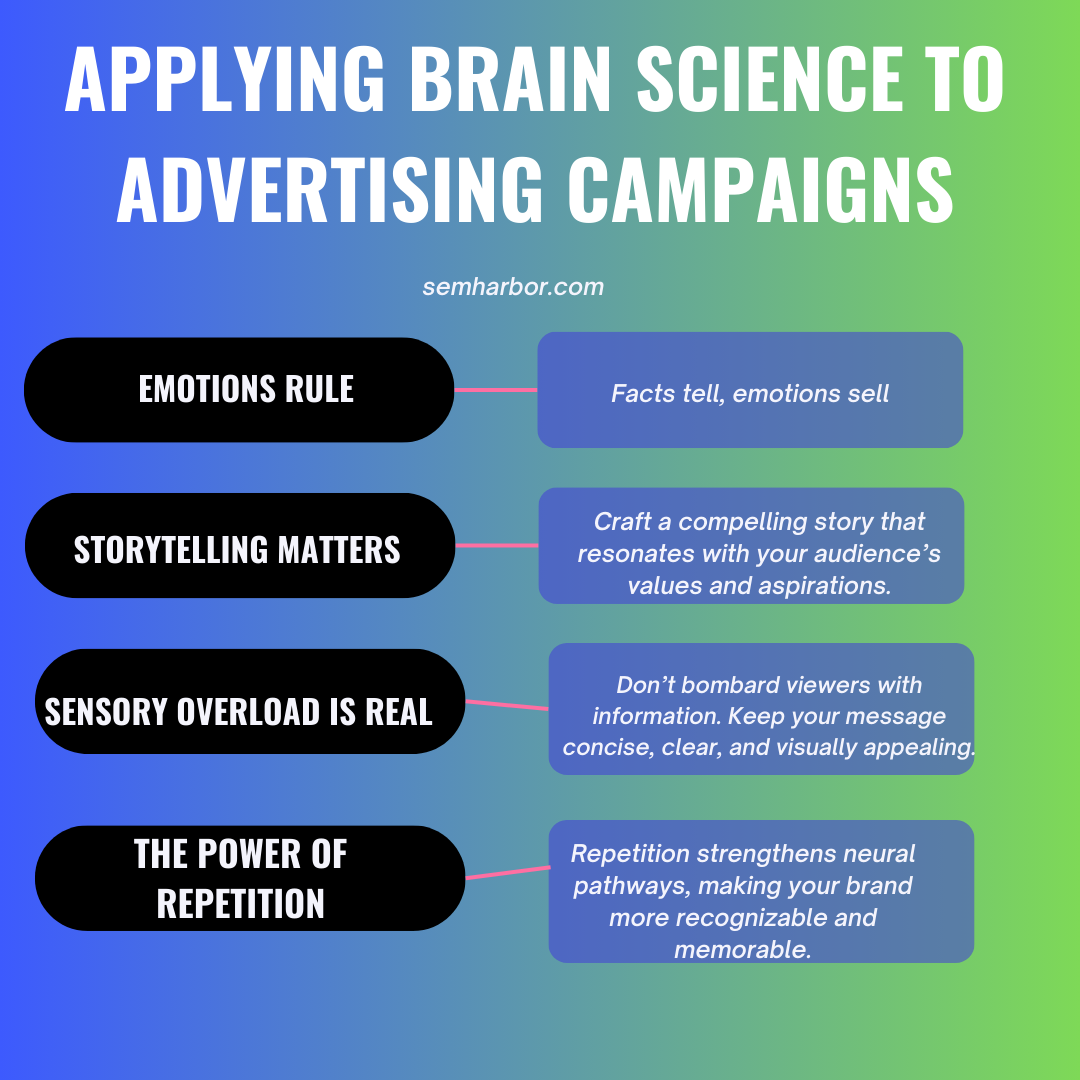
Crack the code of the human brain! Unlock the secrets of effective advertising with the power of neuroscience.
By applying insights from neuroscience, you can craft campaigns that resonate on a deeper level, optimizing visuals and messaging for maximum impact.
Applying Brain Science to Advertising Neuromarketing Campaigns
- Emotions rule: Facts tell, emotions sell. Neuromarketing highlights the power of positive emotions like trust, joy, and humor in driving engagement and purchase intent.
- Storytelling matters: The human brain craves narratives. Craft a compelling story that resonates with your audience’s values and aspirations.
- Sensory overload is real: Don’t bombard viewers with information. Keep your message concise, clear, and visually appealing.
- The power of repetition: Repetition strengthens neural pathways, making your brand more recognizable and memorable. However, avoid being overly repetitive to prevent ad fatigue.
Optimizing Visuals and Messaging for Maximum Impact
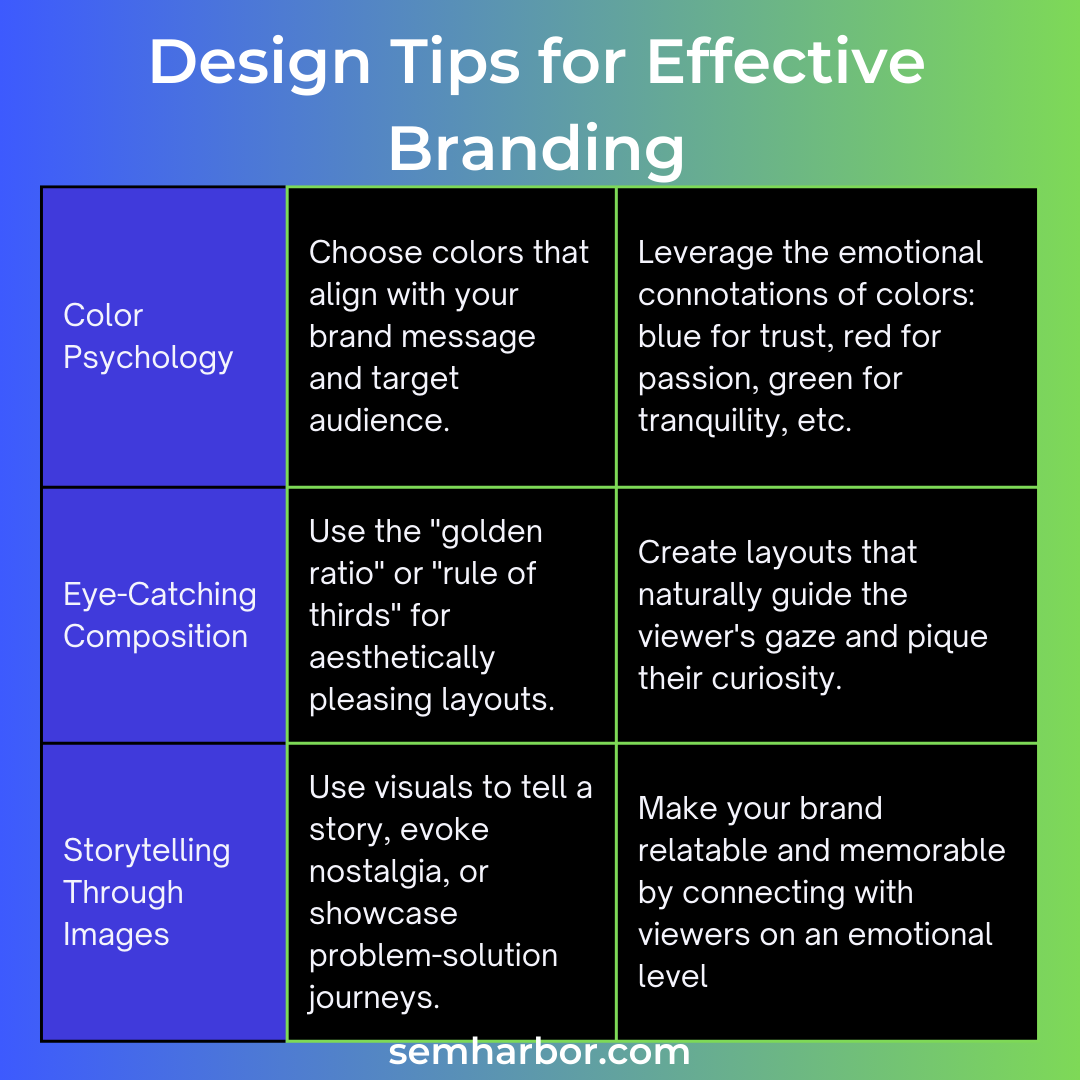
Design tips to make your brand stand out.
The human brain is a visual powerhouse. Processing visuals 60,000 times faster than text, they have the immediate power to capture attention and trigger emotional responses. So, how can you leverage this visual dominance?
- Color Psychology: Colors evoke specific emotions. Blues promote trust, reds ignite passion, and greens radiate tranquility. Choose palettes that align with your brand message and target audience.
- Eye-Catching Composition: Utilize the “golden ratio” for aesthetically pleasing layouts that naturally guide the viewer’s gaze. Employ rule of thirds for dynamic compositions that pique curiosity.
- Storytelling Through Images: Humans crave narratives. Use visuals to tell a story, evoke nostalgia, or showcase problem-solution journeys, making your brand relatable and memorable.
Creating Emotional Connections and Triggering Action
Why Emotions Matter:
- They drive decision-making: Facts tell, emotions sell. People are more likely to remember and act on something that resonates emotionally.
- They build trust and loyalty: When you connect with someone on an emotional level, you create a deeper bond, fostering trust and loyalty.
- They fuel motivation: Emotions can be a powerful motivator, driving people to take action, whether it’s supporting a cause, buying a product, or sharing your message.
Beyond Advertising: Neuromarketing for Product Design and Branding
Think of your favorite product. Its color, shape, even the satisfying click of a button – these elements aren’t random. Neuromarketing research, using tools like EEG and fMRI, identifies which elements trigger specific brain responses associated with pleasure, trust, and excitement.
Imagine a car company using eye-tracking software to optimize dashboard layout, leading your gaze naturally to key information.
Or a cosmetics brand testing packaging colors to evoke feelings of luxury and sophistication.
Building Emotional Connections:
Products are more than just tools; they’re often extensions of ourselves. Neuromarketing helps brands tap into deeper desires and aspirations. A study by BMW showed increased activity in the “reward center” of the brain when participants saw their car customized with personal features. This emotional connection fosters brand loyalty and encourages repeat purchases.
Designing for Intuition:
Ever picked up a product that just “feels right”? Neuromarketing delves into the realm of haptics, understanding how textures and shapes influence perception. Imagine a phone manufacturer optimizing the curve of the device for a more comfortable grip, subconsciously signaling ease of use.
Ethical Considerations:
While the potential of neuromarketing is undeniable, ethical concerns are crucial. It’s essential to use this knowledge responsibly, respecting consumer privacy and avoiding manipulative tactics. Transparency and responsible application are key to building trust and ensuring the technology benefits both consumers and brands.
The Future of Choice:
Neuromarketing is still in its early stages, but its impact is undeniable. By understanding the subconscious drivers of our choices, brands can create products that resonate on a deeper level, forging lasting connections with consumers
Understanding Consumer Preferences and Pain Points
In the hyper-competitive market, understanding your customers isn’t a luxury, it’s a necessity. But simply knowing their names and addresses isn’t enough. Delving deeper into their desires and frustrations – their preferences and pain points – is the key to unlocking true customer loyalty and business success.
Decoding Preferences: The Power of “I Want”
Imagine your customers as a room full of chattering voices. Some whisper about features they adore, others shout about functionalities they crave. These preferences, the “I wants,” are the desires that fuel purchase decisions and brand loyalty. Identifying them empowers you to:
- Craft compelling products and services: Tailor your offerings to directly address their expressed needs and aspirations. Imagine a fitness tracker that not only tracks steps but also analyzes sleep patterns and suggests personalized workouts – a product born from understanding specific user preferences.
- Develop targeted marketing campaigns: Speak directly to their desires in your messaging. Highlight features they value and showcase how your product fulfills their specific needs. Generic marketing fades away; targeted campaigns resonate and convert.
- Boost customer satisfaction: By delivering what they truly want, you create a positive emotional connection. Happy customers become brand advocates, spreading the word and driving organic growth.
Unearthing Pain Points: The Power of “I Ouch”
But the customer journey isn’t all sunshine and rainbows. They also encounter roadblocks, frustrations, and challenges – the “I ouches.” Identifying these pain points is equally crucial, as it allows you to:
- Pinpoint areas for improvement: Analyze common pain points to identify weaknesses in your product, service, or customer experience. Imagine discovering a recurring issue with your app’s login process; fixing it not only eliminates frustration but also demonstrates your commitment to user experience.
- Innovate and differentiate: Use pain points as springboards for innovation. Develop solutions that address their struggles and unmet needs, creating a unique value proposition that sets you apart from competitors.
- Build trust and empathy: Acknowledging and addressing their pain points shows you care. This builds trust and fosters genuine connections, turning customers into loyal brand ambassadors.
Beyond the Surface: Tools for Deeper Understanding
So, how do you tap into this wealth of customer insights? Here are some valuable tools:
- Surveys and polls: Gather quantitative data on preferences and pain points through targeted surveys and polls.
- Customer interviews and focus groups: Gain in-depth qualitative insights through open-ended discussions and group interactions.
- Social media listening: Analyze online conversations to understand broader sentiment and emerging pain points.
- Customer support interactions: Analyze support tickets and interactions to identify recurring issues and areas of improvement.
Remember, understanding preferences and pain points is an ongoing journey. Regularly gather feedback, analyze data, and adapt your approach. By deciphering the “I wants” and “I ouches” of your customers, you’ll unlock the key to building a thriving business that resonates deeply with the hearts and minds of your audience.
Building Brand Loyalty and Emotional Resonance
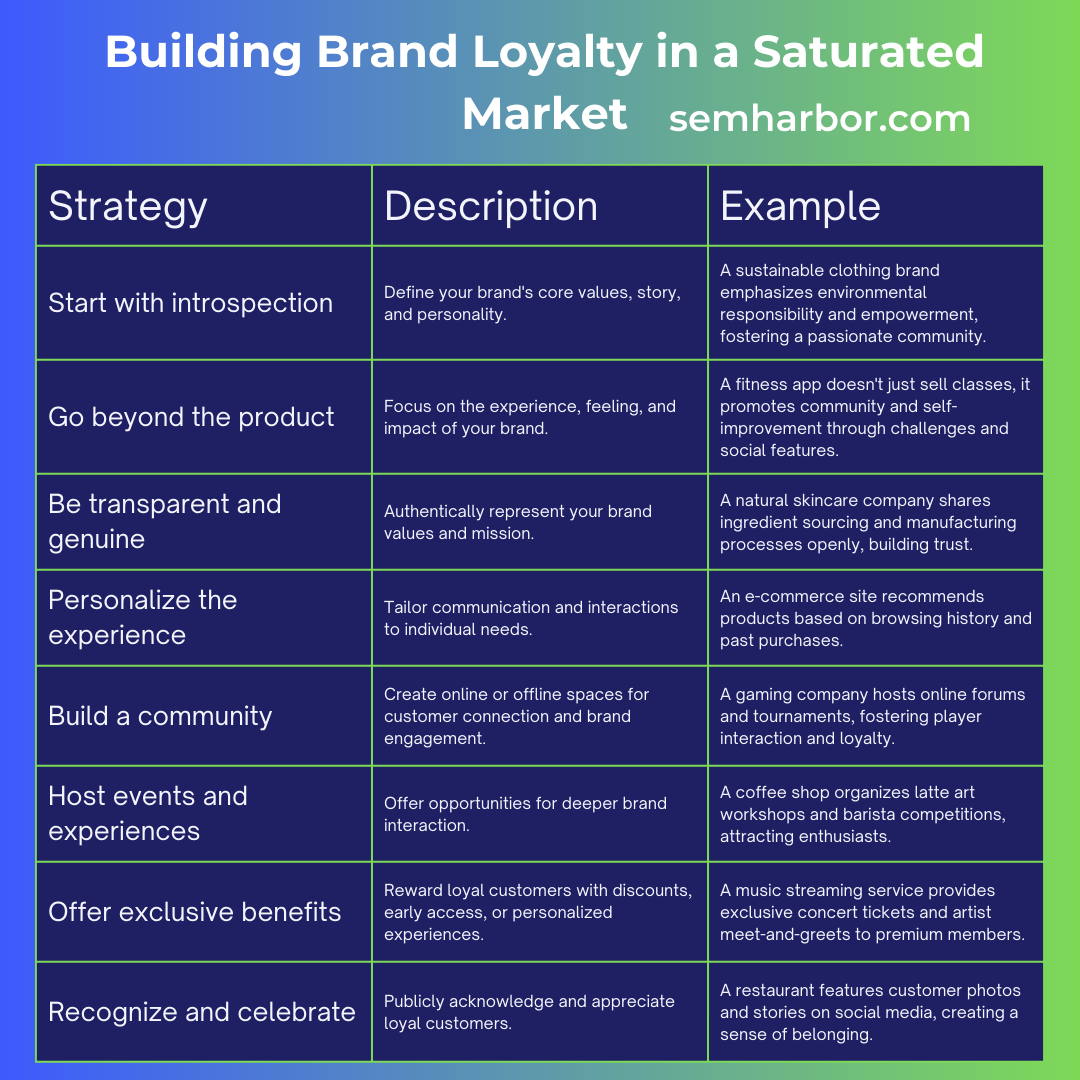
Building brand loyalty in a crowded market is tough, but it’s not impossible. This chart shows some strategies you can use to stand out from the competition and create lasting relationships with your customers.
In a saturated market, where products and services often feel interchangeable, simply offering a good offering is no longer enough. Consumers crave more. They crave connection, they crave meaning, they crave emotional resonance. This is where the true power of brand loyalty lies.
Some key strategies:
- Start with introspection: What are your brand’s core values? What story does it tell? What emotions do you want to evoke? Define your brand’s personality as if it were a living person.
- Go beyond the product: Your brand is more than what you sell. It’s the experience, the feeling, the impact. Think about the values your product embodies and the emotions it helps people achieve.
- Be transparent and genuine: Consumers can smell inauthenticity a mile away. Be true to your brand’s values and mission, and don’t shy away from showing your human side.
- Personalize the experience: Treat your customers like individuals, not just numbers. Tailor your communication and interactions to their needs and preferences.
- Build a community: Foster a sense of belonging by creating online or offline spaces where your customers can connect and with your brand.
- Host events and experiences: Create opportunities for your customers to interact with your brand on a deeper level. This could be anything from product workshops to charitable events.
- Offer exclusive benefits: Show your loyal customers you appreciate them with special discounts, early access to new products, or personalized experiences.
- Recognize and celebrate them: Publicly acknowledge and celebrate your loyal customers. This could be through social media shoutouts, customer testimonials on your website, or even handwritten thank-you notes.
The Power of Sensory Marketing
Visuals bombard us on screens, words blur into a white noise of information, and the “buy now” buttons all start to look the same. So, how do you stand out? How do you create connections that transcend the digital and leave a lasting impression? Enter the world of sensory marketing.
Sensory marketing is all about engaging multiple senses to create a richer, more immersive brand experience.
It’s not just about pretty pictures and catchy slogans; it’s about tapping into the emotional power of sight, sound, smell, taste, and touch.
Why is sensory marketing so powerful?
- Sensory experiences are memorable: Think back to your favorite childhood memory. What do you remember most vividly?
Chances are, it’s not just what you saw, but the sounds, smells, and even the textures you experienced. By engaging multiple senses, brands can create memories that stick with consumers long after the initial interaction.
- Emotions drive decisions: Sensory experiences can evoke powerful emotions, which in turn influence our purchasing decisions.
Think about the calming scent of lavender associated with a spa, or the mouthwatering aroma wafting from a bakery. These scents create positive associations that can nudge consumers towards purchasing.
- Differentiation in a crowded space: In a world saturated with digital messages, sensory marketing offers a chance to stand out. By appealing to the senses, brands can create unique and engaging experiences that cut through the noise and capture attention.
Engaging the Five Senses to Drive Customer Behavior
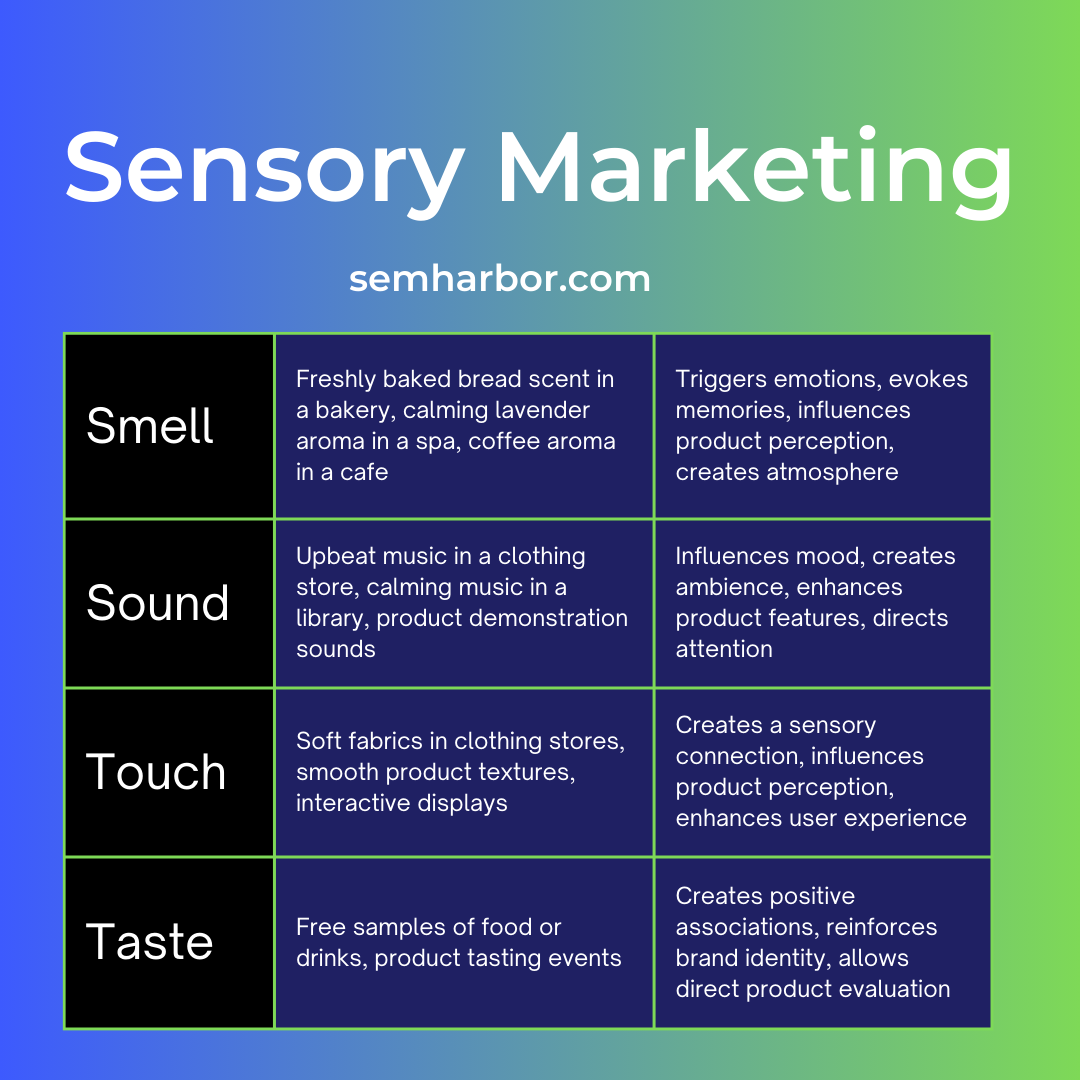
Sensory marketing can engage all five senses to create a more memorable and positive brand experience.
Sight: Colors, Visual Design, and Packaging
The human experience is built on a foundation of senses, each one acting as a portal to understanding the world around us. Among these, sight reigns supreme.
It’s through our eyes that we navigate landscapes, connect with faces, and decipher the countless visual cues that bombard us daily. This inherent reliance on sight makes it a powerful tool for brands and designers, particularly when it comes to the art of packaging.
Color Psychology:
Imagine a world devoid of color. Everything is rendered in bland shades of grey, devoid of the vibrancy and emotional resonance that color injects into our lives.
Packaging, in this scenario, would lose its ability to captivate, tell a story, and forge a connection with the consumer.
Color psychology delves into the fascinating world of how different hues impact our emotions and behaviors.
Understanding these nuances allows designers to craft packaging that not only stands out on the shelf but also resonates with the target audience on a deeper level.
- For instance, red exudes energy and excitement, making it a popular choice for action-oriented products like sports drinks or spicy foods.
- Blue, on the other hand, evokes trust and security, perfectly suited for healthcare or financial products.
- Green signifies nature and freshness, ideal for organic or eco-friendly brands.
By understanding the language of color, designers can create packaging that speaks directly to the emotional core of the consumer.
Visual Design: More Than Meets the Eye
Color is just one piece of the visual design puzzle. Typography, shapes, and imagery all play a crucial role in crafting packaging that captures attention and tells a brand’s story.
Bold fonts and sharp lines might communicate modernity and innovation, while softer curves and script fonts can evoke a sense of comfort and tradition.
The choice of imagery can be equally impactful. A photorealistic image might convey quality and authenticity, while a whimsical illustration might inject a touch of fun and personality.
But visual design is not merely about aesthetics. It also serves a practical purpose.
Packaging needs to be clear and informative, effectively communicating the product’s name, benefits, and ingredients. It should also be easy to handle and navigate, ensuring a smooth user experience.
Striking a balance between visual appeal and functionality is key to creating packaging that truly excels.
The Power of Packaging:
In today’s crowded marketplace, packaging often serves as the first and sometimes only impression a brand makes on a potential customer. It’s a silent salesperson, silently vying for attention on crowded shelves and fighting to be chosen.
By harnessing the power of sight through the strategic use of color, visual design, and functionality, brands can craft packaging that resonates with consumers, tells their story, and ultimately, drives sales.
So, the next time you find yourself drawn to a particular product on the shelf, take a moment to appreciate the silent symphony of sight at play.
The color, the design, the imagery – all meticulously chosen to captivate your attention and tell a brand’s story.
Remember, packaging is more than just a container; it’s a powerful tool that speaks directly to our most visual sense, shaping our perceptions and influencing our choices.
Sound: Music, Jingles, and Auditory Branding
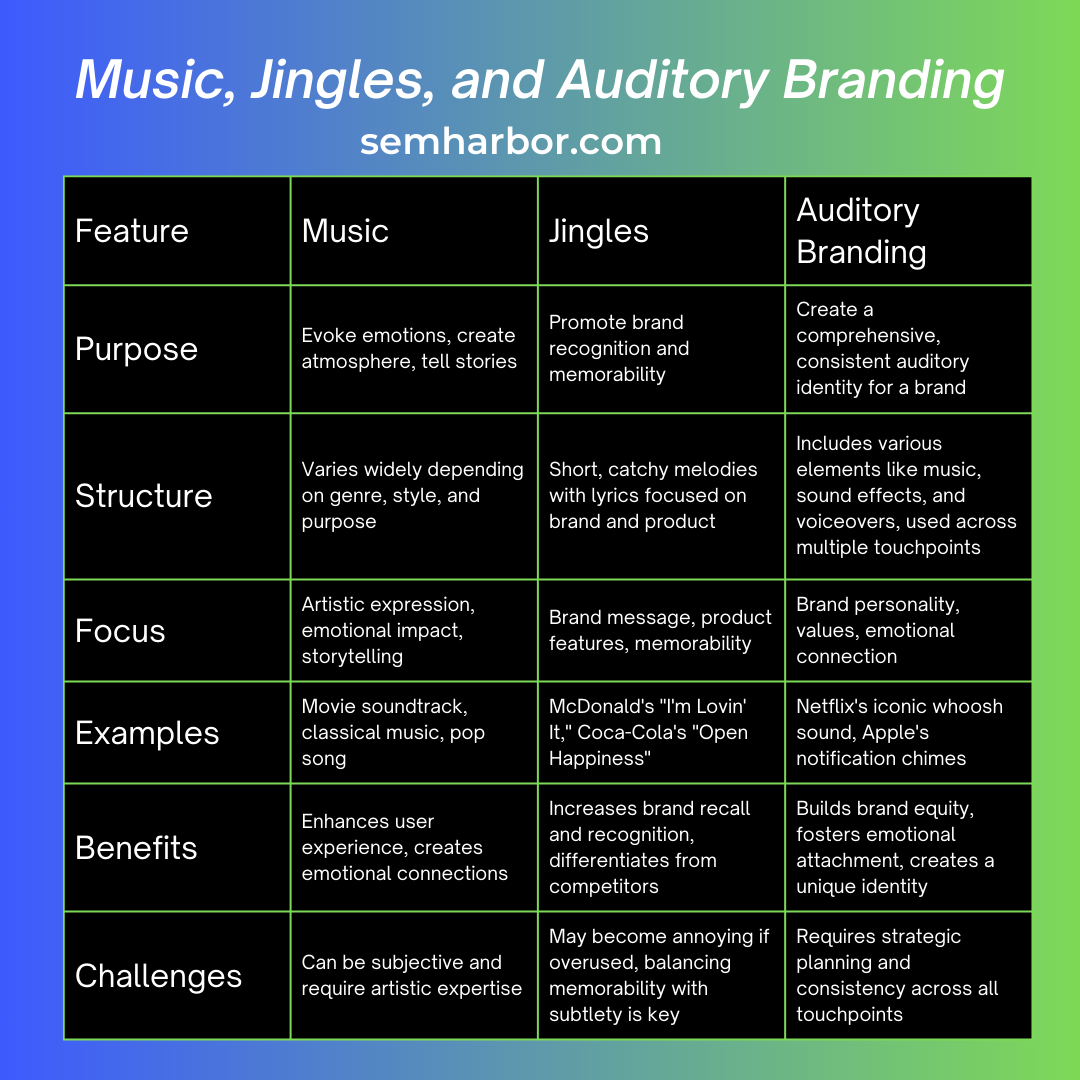
The power of sound: How music, jingles, and auditory branding can shape your brand identity.
is a universal language that transcends words and borders. Jingles, the catchy earworms that burrow into our minds. But in the ever-evolving world of branding, sound goes far beyond these familiar forms. It’s time to explore the exciting realm of auditory branding.
Think of it this way: your brand has a visual identity (logo, colors) and a personality. Auditory branding brings that personality to life with sound. It’s not just about creating a jingle; it’s about crafting a unique soundscape that resonates with your audience on an emotional level.
From Earworms to Emotions:
Jingles have their place, but they’re just one note in the symphony of sound branding. Today, brands are using a wider range of sounds:
- Sonic logos: Short, memorable melodies like the Netflix “th” or Intel “bong” instantly identify the brand without relying on visuals.
- Soundscapes: Imagine the calming spa music or the upbeat energy of a gaming platform. These carefully curated sounds set the mood and enhance the brand experience.
- Voiceovers: A warm, friendly voice can build trust and connection, while a professional tone conveys authority. The right voice can make a powerful statement.
The Science of Sound:
It’s not just about aesthetics. Studies show that sound can:
- Boost brand recall: A familiar tune can trigger instant recognition, even without seeing the logo.
- Shape emotions: Upbeat music energizes while calming melodies evoke relaxation. Sound can influence how customers perceive your brand.
- Tell a story: A carefully chosen soundscape can subconsciously communicate brand values and messages, adding depth and dimension.
Crafting Your Sonic Identity:
So, how do you harness the power of sound? Here are some key steps:
- Define your brand personality: What emotions do you want to evoke? What values do you represent?
- Identify your target audience: What kind of sounds resonate with them?
- Develop a cohesive soundscape: This includes sonic logos, sound effects, music, and even voiceovers, all working together seamlessly.
- Be consistent: Use your soundscape across all touchpoints, from advertising to websites to physical stores.
The future of sound:
With advancements in technology like AI and spatial audio, the possibilities for auditory branding are endless. Imagine personalized soundscapes that adapt to individual preferences, or immersive audio experiences that transport customers into your brand world.
Sound is no longer just background noise. It’s a powerful tool for building deeper connections, telling your brand story, and standing out in a crowded marketplace.
What story is it telling? And how can sound help you write the next chapter?
Remember, sound is more than just catchy tunes. It’s a strategic tool that can unlock the emotional power of your brand and create truly unforgettable experiences.
Smell: Ambient Scents and Sensory Associations
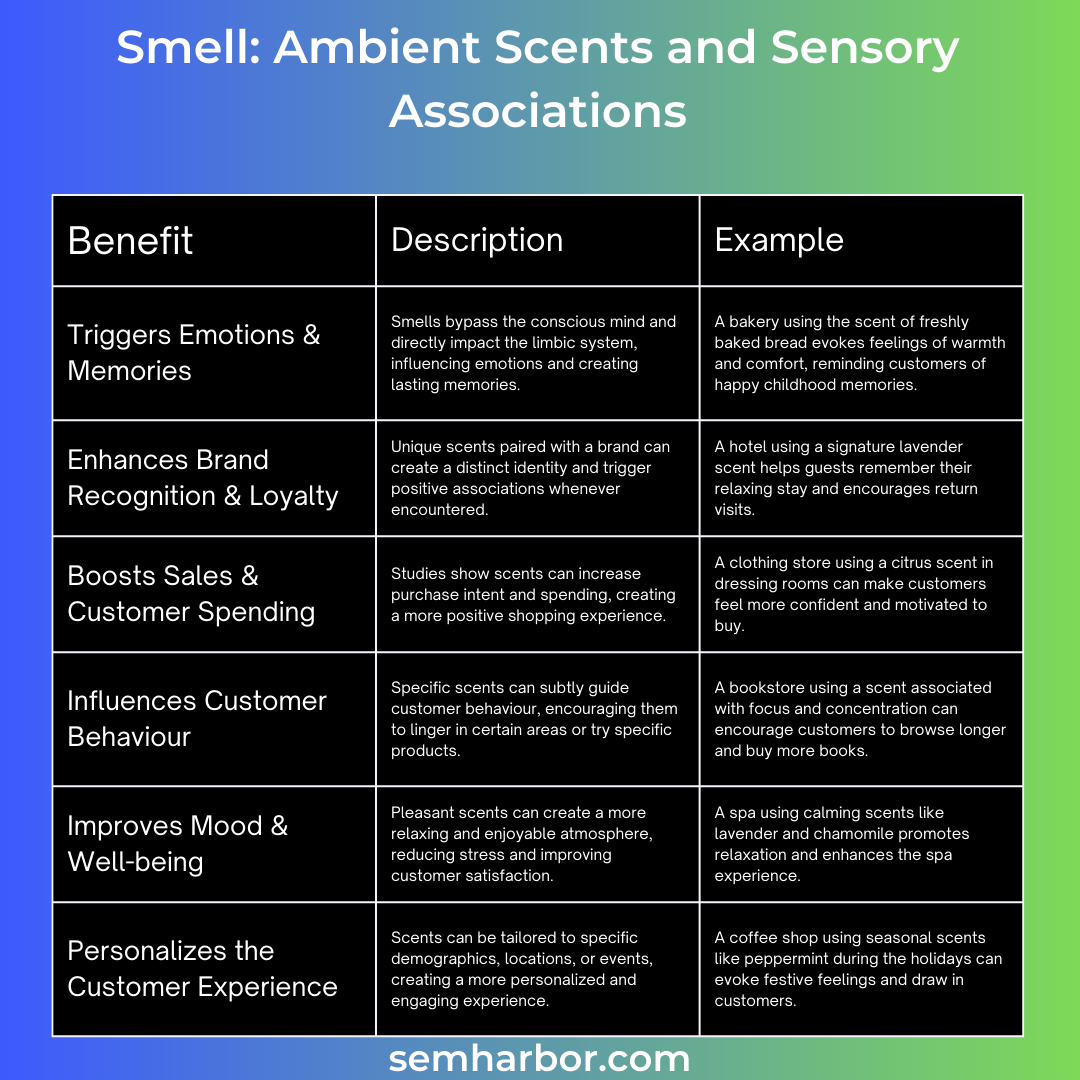
Smell can be a powerful marketing tool, influencing emotions, memories, and behavior.
Imagine walking into a store, not greeted by a friendly cashier, but by the warm aroma of freshly baked cookies. Your mouth instantly waters, and suddenly the mundane task of buying socks feels a bit more delightful.
This, my friends, is the power of ambient scent in marketing, an often overlooked yet potent tool for influencing consumer behavior.
Unlike sight or sound, smell bypasses our conscious mind and directly connects with the limbic system, the brain’s emotional center.
This unique pathway makes scent incredibly powerful in creating sensory associations that influence our perception and behavior.
Here’s how marketers harness this invisible influence:
- Setting the Mood: A bakery might use the aroma of vanilla and cinnamon to evoke feelings of warmth and comfort, encouraging longer stays and increased spending. Conversely, a high-end clothing store might opt for a clean, citrusy scent to convey luxury and sophistication.
- Triggering Memories: The smell of freshly cut grass might remind you of childhood summers, subconsciously making a garden center feel more inviting. Similarly, a spa might use lavender to evoke feelings of relaxation and well-being, enhancing the treatment experience.
- Branding with Scent: Signature scents can become synonymous with a brand, creating a unique and memorable identity. Think of the iconic “Apple Store smell” or the fresh, herbal aroma of Abercrombie & Fitch. These scents become instant brand identifiers, even before you see a logo.
- Influencing Purchase Decisions: Studies show that pleasant scents can increase purchase intentions and spending. For example, a car dealership might use a “new car smell” to make vehicles seem more appealing, while a grocery store might use the scent of ripe fruit to entice customers.
But remember, scent is a double-edged sword. The wrong aroma can backfire, creating negative associations and driving customers away. Consider these factors:
- Cultural Sensitivity: Scents that appeal to one audience might offend another. Do your research and choose culturally appropriate aromas.
- Intensity Matters: Overpowering scents can be overwhelming. Opt for subtle, pleasant fragrances that enhance the atmosphere without being intrusive.
- Individual Preferences: Not everyone enjoys the same scents. Consider offering fragrance-free zones or allowing customers to opt out of the ambient scent.
Touch: Product Texture and Tactile Experiences

A table outlining the benefits of using tactile experiences in marketing, such as increased brand engagement, enhanced perceived value, and stronger brand storytelling.
The Science of Touch: It’s not just nostalgia. Neuroscience tells us that touch is our most primal sense, triggering emotional responses and forging lasting memories.
Products with pleasing textures are perceived as higher quality, more desirable, and even more trustworthy.
The Tactile Revolution: Forget flat, lifeless images. Brands are now embracing haptic marketing, incorporating textures into packaging, product displays, and even digital experiences.
Imagine feeling the softness of a cashmere sweater through your phone screen, or the coolness of a metal watch.
These interactive elements pique curiosity, increase engagement and ultimately drive sales.
From Sampling to Sensory Storytelling: Food brands have long mastered the art of sampling, allowing customers to taste and experience their products firsthand.
Now, the trend is expanding to other sectors. Think of furniture stores with touch-me fabrics, or beauty counters where customers can experiment with different textures.
This hands-on approach builds trust and allows consumers to connect with the brand on a deeper level.
Beyond Products: Packaging Matters: Don’t underestimate the power of a well-designed package.
Think of the satisfying weight of a premium product in your hand, the smooth feel of recycled cardboard, or the intriguing texture of a blind embossment. Packaging is a sensory experience in itself, setting the tone for the brand and product within.
The Future of Touch: As technology evolves, the possibilities for tactile marketing are endless.
Imagine 3D-printed product samples delivered to your home, or augmented reality experiences that allow you to “virtually” touch and interact with products.
The future of marketing is sensory, immersive, and deeply personal.
Remember: Touch is not just about selling products; it’s about creating emotional connections. By incorporating texture and tactile experiences into your marketing strategy, you can stand out in a crowded digital world and build relationships that last. So, go ahead, get hands-on, and unleash the power of touch!Bonus Tip: Encourage user-generated content by asking customers to share their own tactile experiences with your brand using specific hashtags. This builds community and amplifies your message organically.
Ready to touch the future of marketing? Start by asking yourself:
- What textures can I incorporate into my packaging and product design?
- How can I create interactive displays that encourage touch?
- Are there opportunities for sampling or sensory storytelling in my marketing campaigns?
Taste: Food and Beverage Marketing with Sensory Appeal
- Texture: Crispy, creamy, melt-in-your-mouth – these textures tell a story and create anticipation. Think of the satisfying crunch of a fresh apple or the velvety smoothness of a chocolate ganache.
- Temperature: A steaming hot cup of cocoa warms the soul, while a chilled glass of lemonade quenches thirst. Temperature creates a unique experience and can influence flavor perception.
- Acidity and Spice: A zing of citrus or a kick of chili pepper can add excitement and depth. Play with these elements to create dynamic flavor profiles and cater to different preferences.
Beyond the Tongue:
The other senses play a crucial role in crafting a memorable experience:
- Sight: Visuals go beyond just aesthetics. Use vibrant colors, appetizing textures, and playful presentation to pique curiosity and trigger cravings.
- Smell: The aroma of freshly baked bread or sizzling steak can be just as enticing as the taste itself. Utilize in-store scents, infused packaging, or even scratch-and-sniff elements to engage the olfactory sense.
- Sound: The sizzle of a burger on the grill, the clinking of ice in a glass, or the satisfying crunch of a chip – these sounds add another layer of sensory immersion and can subconsciously influence taste perception.
Crafting a Multisensory Symphony:
Don’t just showcase your product; orchestrate an experience. In-store tastings, cooking demonstrations, and interactive events allow consumers to engage with all their senses. Partner with other brands to create unique sensory combinations, like a chocolatier pairing with a coffee roaster.
Remember:
- Know your audience: Tailor your sensory appeal to your target demographic’s preferences and cultural context.
- Be authentic: Don’t force it. Let your brand’s personality and product story shine through naturally.
- Consistency is key: Maintain a cohesive sensory experience across all touchpoints, from packaging to advertising to in-store interactions.
Real-World Examples of Sensory Marketing in Action
Sensory marketing isn’t just a fancy phrase – it’s a powerful tool that taps into the subconscious, forging emotional connections and boosting sales.
By stimulating sight, smell, touch, taste, and sound, brands can create immersive experiences that leave a lasting impression. But how does it work in practice? Let’s delve into the fascinating world of sensory marketing through real-world examples:
- Sight: Think beyond just visuals. Apple stores are renowned for their clean, minimalist aesthetic, exuding a sense of premium quality. Disney theme parks transport guests into vibrant, immersive worlds, while Tiffany & Co.’s robin’s-egg blue packaging instantly evokes luxury. Remember, sight is the first impression, so make it count.
- Smell: The power of scent is undeniable. Abercrombie & Fitch uses a signature fragrance to create a memorable brand experience, while Starbucks’ aroma beckons passersby. Hotels like Westin infuse their lobbies with calming scents, and even car dealerships use new car scents to trigger positive associations.
- Touch: Texture matters! Lululemon’s buttery-soft fabrics scream comfort and quality, while Tesla’s sleek interiors invite exploration. Moleskine notebooks with their tactile covers and thick paper create a satisfying writing experience, and Lego’s unique click sound reinforces the building process.
- Taste: Who can forget the free samples at Costco? Food samples trigger impulse purchases and create positive associations. Wine tastings allow customers to connect with the product and build brand loyalty, while restaurants like Nobu use artistic plating to elevate the dining experience.
- Sound: Music sets the mood. Apple uses upbeat, trendy music in their stores, while airlines like Singapore Airlines curate calming playlists for a relaxing journey. Casinos use stimulating sounds to keep players engaged, and luxury brands often incorporate classical music to create an air of sophistication.
Bonus: Multisensory Magic: The real power lies in combining senses. ThinkCinema elevates the movie experience with motion seats, wind effects, and even food scents corresponding to the film.
Ikea’s showrooms create realistic home environments, engaging multiple senses to encourage product visualization.
Sensory marketing isn’t just about gimmicks; it’s about understanding your audience and creating a holistic brand experience. By appealing to all five senses, you can forge deeper connections, boost brand recall, and ultimately, drive sales
Tips and Strategies for Implementing Sensory Marketing

Sensory marketing can engage all five senses to create a more memorable and positive brand experience.
- Know Your Audience: Before diving in, understand your target audience’s preferences and cultural sensitivities. What colors evoke positive emotions? Do specific scents trigger pleasant memories? Research and tailor your sensory experience accordingly.
- Sight: A Feast for the Eyes: Visuals are the first impression, so make it count. Utilize high-quality imagery that reflects your brand identity and showcases your products in an appetizing light. Experiment with bold colors, dynamic layouts, and even interactive elements to grab attention.
- Sound: The Soundtrack to Success: Music plays a powerful role in setting the mood. Choose melodies that align with your brand personality and target audience. Upbeat tunes energize while calming rhythms create a relaxing atmosphere. Remember, silence can be powerful too, especially in high-traffic areas.
- Touch: A Tangible Connection: Let customers experience your products firsthand. Offer textured packaging, interactive displays, and soft fabrics to spark curiosity and encourage engagement. This tactile connection builds trust and emotional attachment.
- Taste: A Delicious Differentiation: If your product lends itself to it, offer samples or tasting experiences. Not only does this allow customers to evaluate the quality, but it also creates positive associations with your brand. Think warm cookies in a bakery or refreshing beverages in a clothing store.
- Smell The Memory Trigger: Scents have an unparalleled ability to evoke emotions and memories. Choose pleasant, subtle aromas that align with your brand identity and target audience. For example, a bakery might use the warm scent of cinnamon, while a spa could opt for calming lavender.
- Go Multi-Sensory: The true magic happens when you combine multiple senses. Imagine the warmth of a crackling fireplace paired with the aroma of pine needles and festive music in a winter clothing store. This multi-sensory experience creates a powerful emotional connection that customers won’t soon forget.
- Be Authentic and Consistent: Sensory marketing should be natural and congruent with your brand identity. Don’t force gimmicks that feel out of place. Ensure all sensory elements complement and reinforce each other to create a cohesive and impactful brand experience.
- Measure and Adapt: Don’t just implement – track and analyze the results. Conduct A/B testing to see which sensory elements resonate most with your audience. Continuously refine your strategy based on data and customer feedback to maximize your impact.
By integrating these tips and unleashing the power of sensory marketing, you can transform your brand experience, forge deeper customer connections, and drive sales. Remember, sensory marketing is about more than just aesthetics – it’s about creating emotions, memories, and a desire to connect with your brand on a deeper level.
The Future of Neuromarketing and Sensory Marketing
Our five senses are gateways to memory, emotion, and ultimately, buying decisions. The future of sensory marketing will weave a multisensory tapestry of experiences. Imagine physical stores using biometrics to adjust temperature and scent based on individual preferences, creating a truly personalized atmosphere.
Virtual reality experiences could incorporate haptic feedback, taste simulations, and even biofeedback-driven environments, blurring the lines between reality and brand immersion.
However, the potential for sensory overload and manipulation is real.
The ethical responsibility lies in creating authentic, enriching experiences that enhance brand interaction, not bombard consumers with overwhelming stimuli.
Think of calming music in airports reducing stress, or subtle scent diffusers in libraries promoting focus – sensory marketing used to improve overall well-being alongside brand engagement.
The Ethical Tightrope: Balancing Innovation and Responsibility
Both neuromarketing and sensory marketing offer immense potential, but ethical considerations cannot be ignored.
Transparency, informed consent, and responsible data usage will be the cornerstones of success. Imagine a future where these fields are used to understand consumer needs better, create personalized experiences, and even promote well-being.
This requires open dialogue and collaboration between researchers, marketers, and consumers to define ethical boundaries and ensure technology serves humanity, not exploits it.
The future of these fields is not about mind control or sensory manipulation but about deeper understanding and meaningful connection.
By harnessing the power of the human brain and senses responsibly, we can create a future where marketing enriches lives, resonates deeply, and builds genuine trust with consumers.
The journey awaits, and the question remains: are we ready to walk the ethical tightrope and unlock the true potential of these fascinating fields?
